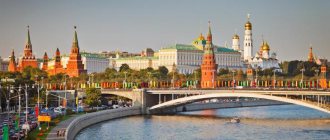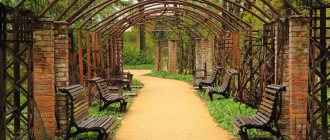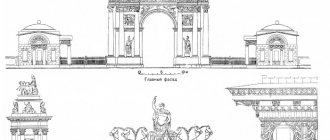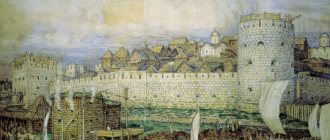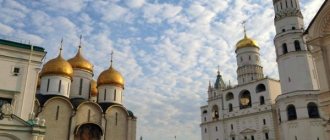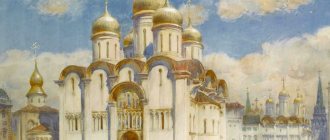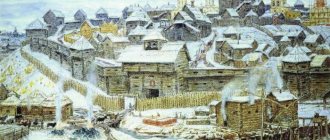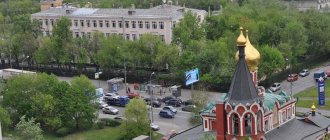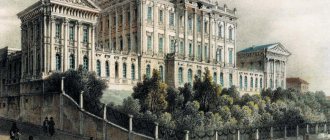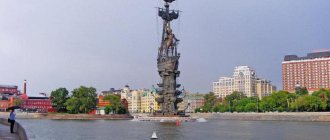Botanical gardens are oases in which botany, research and a whole range of related sciences constitute the cultural heritage of not only a particular country, but the entire planet as a whole. Thanks to these territories, not only scientific dogmas are popularized, but also a responsible attitude towards nature; people learn to contemplate the world, and not just consume the benefits of civilization.
All the largest botanical gardens in the world have their own unique flavor, which lies in their historical value, originality of compositions, features of receiving visitors and other aspects. Spending time on these living monuments of Science and enjoying the authentic beauty of nature is a mandatory part of the life goals of a passionate traveler. Let's look at the most interesting gardens from around the world. For ease of reference, we have added a video that clearly shows many of the beauties of this or that garden.
History of the formation of the Main Botanical Garden
GBS was founded in April 1945 as one of the events in honor of the 220th birthday of the USSR RAS. More than 360 hectares of land were allocated to organize a botanical garden in the Ostankino Forest Park.
The first mention of this land dates back to 1584. Then the territory belonged to the princes of Cherkasy. After some time, it was transferred to Sheremetev and received the name “Ostashkovo village”. Together with the estate located here, the forest park area was the dowry of Varvara Cherkasskaya, the wife of Peter Sheremetev. Over time, the English Park was created. This was done by Count Nikolai Sheremetev, the owner of Ostankino. In order to create a natural landscape, the count hired a gardener originally from England. On the huge area of the Main Botanical Garden of the Russian Academy of Sciences, lindens, oaks and maples, viburnum and honeysuckle were planted, 5 ponds were dug, the water into which came from the Kamenka River.
A unique forest area of the Russian capital was allocated for the formation of the largest botanical garden in Europe. And only thanks to the work of the scientific staff, it was possible to preserve intact and intact fragments of the ancient grove, oak grove and forest. From the day of its founding and for 24 years, the USSR Academy of Sciences transferred into the ownership of the GBS the lands on which the main exhibitions are now located.
The first director of the park is Nikolai Vasilyevich Tsitsin. Actually, that’s why the GBS RAS bears his name. Nikolai Vasilyevich is the founder of the garden, under his leadership the design of the territory was carried out and scientific and laboratory activities took place.
From the first days of the existence of the Main Botanical Garden of the Russian Academy of Sciences named after N.V. Tsitsin, famous scientists worked there, which had a positive effect on the construction time and subsequent development of the park. Today, 150 researchers work here. GBS RAS also trains scientific personnel - over the entire period of its existence, about 200 people have studied in graduate school.
From the moment the garden was founded, the management recognized the expediency of exchanging experience and results of scientific research with other botanical gardens of the USSR. To achieve this goal, periodic production of serial printed publications began in 1948. The materials presented in the articles talked about all the important moments in the world of botany and in the life of the Main Botanical Garden in particular.
Since 1976, the GBS RAS has been cooperating with the United States on the problem of protecting endangered plants. In order to preserve the environment, joint expeditions are regularly conducted to regions of the USA and CIS countries.
Japanese garden
Photo: Sergey Vedyashkin / AGN “Moscow”
Photo: Sergey Vedyashkin / AGN “Moscow”
Photo: Alexander Avilov / AGN “Moscow”
Photo: Alexander Avilov / AGN “Moscow”
During the cherry blossom season, people line up at the trees to take photos. Photo: Sergey Vedyashkin / AGN “Moscow”
In autumn, the Japanese Garden is no less beautiful. Photo: Shutterstock.com
From the Manchurian walnut to the northeast - and here we have, perhaps, the most popular exhibition of the Main Botanical Garden. Every year, the Japanese Garden attracts tens, or even hundreds of thousands of visitors - most of all, naturally, in the spring, when a huge territory of almost three hectares is painted a soft pink color. Yes, yes, these are cherry blossoms.
GBS boasts the most “northern” Japanese garden in the world. It was opened in 1987 according to the design of the architect K. Nakajima and with the support of the Japanese Embassy. The work was carried out for more than one year, the approach was the most thorough. Building materials from the Land of the Rising Sun, an authentic 150-year-old pagoda, which today is in the center of the landscape composition, a variety of flora and even a separate house for a tea ceremony (alas, this experience can be experienced only two days a year) - every detail reflects the oriental philosophy and purely Japanese character. By the way, in the 80s, the first sakura was planted in the garden by the then Japanese Foreign Minister Shintaro Abe. Almost thirty years later, a seedling grown from the seeds of this tree will be planted by his son, Prime Minister Shinzo Abe.
The Japanese garden is open during the warm season, from April to October. Entrance to the territory is paid, excursions are available.
Description of the forest park area
The park covers an area of 361 hectares. Of these, 52 hectares are allocated to the park area, and the same amount is occupied by a protected oak forest. There are exhibitions on another 150.4 hectares. GBS RAS has a huge number of plants. The collections include the flora of all countries that were once part of the USSR, tropical and subtropical, cultivated and floral and ornamental plants. In total, more than 8,000 forms and varieties, about 8,200 species are collected here, and the total number of taxa is about 16,300 elements.
History of origin
Trees have always played an important role in the plant world, as throughout human history they have brought enormous benefits to people. In the 18th century, works on dendrology appeared, but they only reflected a description of the external characteristics of plants. Later, scientists began to study problems such as the acclimatization of trees, the study of their genetics, and the creation of new species. Particular attention was paid to introduction - the introduction of crops into places that are not typical for their growth.
Structural and non-structural formations
Main Botanical Garden named after. N.V. Tsitsina in Moscow includes departments:
- dendrology;
- flora;
- ornamental plants;
- plant protection;
- tropical and subtropical plants;
- distant hybridization;
- cultivated plants;
- implementation of the latest developments.
And laboratories:
- plant biotechnology;
- physiology and biochemistry;
- landscape architecture;
- physiology and immunity of plants;
- herbarium.
The structural scientific unit also includes a branch located in the city of Cheboksary - the Cheboksary Botanical Garden.
Non-structural scientific departments include the group of chemosystematics and evolutionary biochemistry of plants. In addition, scientific and auxiliary units have been organized in the botanical garden, including the Altai stronghold and other production services responsible for maintaining the garden territory and conducting research work. Since 1947, a scientific library has been operating, which is a department of the Library of Natural Sciences of the Russian Academy of Sciences.
The challenges facing these objects
Dendrological parks and botanical gardens are directly related to the lands of specially protected areas. They represent a separate category of protected areas, where special collections of plants are created in order to enrich the flora and preserve biodiversity. In addition, they are necessary for educational, scientific and educational activities. These environmental institutions are developing the scientific foundations of landscape architecture, ornamental gardening, gardening, introducing wild plants into cultivation, protecting them from pests and diseases, and much more.
Schematic representation of the Main Botanical Garden named after N.V. Tsitsin
The layout of the GBS RAS can be seen most clearly on the map. There are several entrances to the botanical garden from different sides:
- the main one is from the side of the street. Botanical;
- from the side of the Ostankino Hotel;
- from the street Komarova;
- from the metro - Vladykino station.
The following objects are numbered in the diagram:
- arboretum;
- reserved oak grove;
- rose garden;
- shady garden;
- coastal plants;
- continuously flowering plants;
- exposition of plants of natural flora;
- Japanese garden;
- cultivated plants;
- natural forest;
- laboratory;
- stock greenhouse;
- new greenhouse.
Good traditions
“At every exhibition of orchids, roses, and daylilies, summer residents come, look at the blossoming plants, and take photographs. Why doesn't their interest wane? What is it based on?
– Many gardeners, before buying a new plant for their dacha, come to us and take a closer look at it, because in a nursery you can’t determine anything from a seedling - it’s not clear what it will turn into after a few years. And here you can often see these same plants of adult size. Let's say trees and shrubs. Here they are already adults, and it immediately becomes clear how many meters this representative of the variety will stretch, whether it will become tall or squat, what shape the crown will take: pyramidal, oval, ovoid, umbrella-shaped, weeping, spherical, creeping or cushion-shaped. Having seen a plant in full size, it is easier to imagine it on your site and create a composition.
Heather Hill - here is a rich collection of rhododendrons, heathers, blueberries and blueberries. Photo: Arseny Kosterin
In addition, we have a wide representation of such garden favorites as coniferous plants: 10 years ago we created a unique exhibition “Coniferous Hills”. The two hills display more than 150 species, varieties and forms of conifers from Eurasia and North America. This is not just an educational botanical collection, but an expressive landscape work. And there are so many flowers alone! We have the only open-air Orchid Garden in Russia, a huge Hydrangea Garden, and Heather Hill with an impressive collection of rhododendrons and heathers. In spring, 100 thousand tulips, exotic magnolias and sakura bloom here.
Article on the topic
Three colors of hydrangea. How to choose and effectively place seedlings in the garden
By the way, about hydrangeas - clearly underestimated by our gardeners! On excursions around the “Apothecary Garden” you can see the width of the growth of an individual clump, evaluate the shade of foliage, and the abundance of flowers. Most often, hydrangeas bloom in the second half of summer, and their decorative peak is at the end of the warm season. Here they are already painted in pink and red tones. Hydrangeas come in a variety of sizes, from miniature to large. They grow without problems and do not cause any trouble.
– Hydrangea is good, but hosta is even better. There is no need to bother with pruning or install supports for heavy “bunches”; the hosta grows and blooms on its own.
– We recently opened the largest Garden Hosta in Russia, where more than 100 varieties are presented: from large ones, reaching a height of more than 72 cm, to miniature ones - less than 15 cm. By the way, many varieties of foreign selection are bred into a separate group and have “mouse” names – for example, the “Mouse Ears” variety. These laconic and neat plants are good for decorating ponds, rock gardens, flower beds, lawns and lawns. Florists use their leaves when making bouquets. The leaves are of different colors - from yellowish and bluish to emerald green with a white or yellowish border.
Garden of medicinal herbs. The collection contains more than 200 plant species. Photo: Arseny Kosterin
Collection funds
On the square allocated for the Main Botanical Garden of Moscow, several exhibitions dedicated to different parts of the world have been recreated:
- "Caucasus".
- "European part of Russia".
- "Middle Asia".
- "Far East".
- "Siberia".
- "Useful plants."
The greenhouse is the place where plants are grown and then supplied to all botanical gardens located in Russia and the countries of the USSR. The collection began with the orchid family: just over 100 Paphiopedilum and 120 Cattleya hybrids, and 140 other orchid genera. All of them were brought from Germany in 1947. Today the collection has expanded significantly and has been supplemented with other plant species. There are more than 1120 of them in total. Of these, 300 are hybrids and 222 subspecies and forms of orchids.
Sochi Arboretum, Russia
The Sochi Arboretum was founded at the end of the 19th century and has an area of 49 hectares. This is a unique combination of subtropical plants and park architecture. There is a collection of palm trees, oaks, pine trees, and rhododendrons. The arboretum is located on the mountainside and its structure is reminiscent of French terraced gardens, and its top can be reached by cable car.
New greenhouse
Recently, the construction of a new greenhouse was completed within the Main Botanical Garden. The building is a structure with a height of over 33 m and an area of approximately 9,000 m². Several blocks have been formed here, each of which meets certain climatic conditions. So, in the new greenhouse there are blocks “Moist forests”, “Tropics” and “Subtropics”. To create a naturalistic landscape, cascades of pools, rivers, waterfalls and reliefs were organized, trail systems were laid, artificial rocks and grottoes were formed. Here you can even make a tropical fog and “cause” rain - all so that the plants develop in their usual conditions.
Feelings have awakened!
– The tactile garden was one of the first to open after quarantine. How great is the need for it among city residents?
– This is a unique garden of this type in Russia; there are no such gardens anywhere else. Only here you can touch the plants and even taste them. We help people regain joy from the perception of the world around them - through the development of the five senses: smell, touch, vision, hearing and taste. We paid special attention to accessibility. For example, to develop the sense of smell, there is an area with raised wooden beds. People with disabilities drive up to the garden bed in a wheelchair, and the plants are right at their eye level. Here you can touch them - each plant is unique! Well, if you touch aromatic herbs... An amazing bouquet of smells from thyme, lavender, strawberries, lemon balm, rosemary, mushroom herb, thyme and verbena!
– I see that you have installed sandboxes at a high altitude. For what?
– Healers of Ancient Greece and Egypt actively used purified quartz sand to improve the health of patients. Today, psychologists have proven the therapeutic effect of playing in the sand. Raised sandboxes were made for parents and grandparents; they don’t have to bend over backwards to make Easter cakes.
– And there is also a path of squares filled with cones, large and small pebbles, and sand. Walk along it barefoot - get a foot massage?
– Yes, this practice came from Ancient China. There were even schools teaching foot massage techniques. There are many active points concentrated on the soles: by acting on them, we increase blood flow to the internal organs, which improves their functioning. Unfortunately, city dwellers have lost the habit of walking barefoot, but at the dacha you can always find a few free meters and create such a tactile platform.
Pergola entwined with grapes, hops and honeysuckle. Photo: Arseny Kosterin
– But I always like not only to please my eyes, but also to definitely taste something. What do you offer visitors to develop their sense of taste?
– Oh, we have a whole Sensory Garden open! Here you can try a variety of tomatoes, peppers and other vegetables with excellent taste. By the way, in our time, not all children know exactly how vegetables, fruits and herbs grow, because they see them exclusively in plucked and cooked form. We want to introduce children to gardening, cultivation culture, and introduce them to communication with nature.
Interesting facts, or why you should visit the park
- A unique opportunity to get acquainted with plants growing in our country and abroad.
- Japan in Russia – the Japanese garden has cherries and azaleas, a gazebo and a small pond. This is a great place for those who want to be alone.
- Within the Main Botanical Garden named after. Tsitsin (GBS RAS) there is an opportunity to take a walk in the forest, in which a wide variety of trees grow, for example, catalpa, white acacia, Japanese quince, North American thuja, hornbeam and much more.
- Several ponds have been created here, strewn with water lilies, near which it will be pleasant to relax.
- In the greenhouse, which was already mentioned above, you can take a tour. Who doesn’t want to find themselves in the tropics in the middle of a noisy metropolis?
It will be interesting to know that the Moscow Botanical Garden takes part in many international exhibitions. GBS was awarded 30 diplomas, the collection includes more than 100 gold, silver and bronze medals.
The most unusual plants
Baobabs are one of the thickest trees, whose diameter can reach 8 m and height up to 25 m.
Rafflesia consists of only a flower. And this is the largest flower on the planet (about 2 meters in diameter). But the fact is that in addition to its beauty, the flower creates a very unpleasant smell of rotting flesh. This smell is very attractive to flies.
Amorphophallus gigantea or Corpse Flower. The second largest flower in the world after Rafflesia. This plant also emits a disgusting smell of rotten eggs and rotting meat to attract insects for pollination. This plant holds the title of “The Smelliest Flower in the World.”
Velvichia. Not only that, this “flower” can live for 5 years without rain, receiving the necessary moisture only from the atmosphere. Also, its life expectancy is from 400 to 2000 years. He looks strange, of course.
Dragon tree. The strange appearance of this tree is not its main distinguishing feature. The plant has tree sap that is red in color, like blood.
Porcupine tomato. The leaves of the plant are covered with terrifying orange spines. By the way, the thorns are prickly and poisonous.
Hand of Buddha. The plant looks like a lemon. In Japan they make tea from it, and in China they keep it at home as a talisman that brings good luck and happiness to the house. These lemon tentacles are also used to make jam, marmalade and violet-scented perfume.
Buddha is a spiritual teacher among eastern peoples.
Chinese mouseflower. This is not a bat. And not a spider. This is such a plant.
Doll eyes. This plant does not have any special features other than its appearance.
In distant and hot Latin America there grows an amazing tree with the beautiful name Jaboticaba . Twice a year, its trunks and branches are covered first with small white inflorescences, which from a distance look like poplar fluff, and then with tiny berries the size of grapes.
The milk tree grows in Central and South America. These are low trees with shiny and thick leaves with inedible fruits. Local residents drink the juice of this plant as milk. When the juice is boiled, wax is released on its surface, which is used to make candles and chewing gum.
"Breadfruit". Breadfruit bears up to 200 fruits per season. And it is one of the most productive trees, especially since each loaf of bread weighs 3-4 kilograms. These fruits are a staple food for the inhabitants of tropical islands. The fruits are eaten fried, baked, and boiled. This food tastes like potatoes and bread. And fried breadfruit is like fresh bread. Hence the name.
The sausage tree grows in Africa. On tall trees grow inedible fruits that closely resemble sausages. These trees are called kigelia , or "sausage" trees .
Kigelia fruits are completely inedible. But hippos eat them and parrots pick out the seeds.
Local residents use the sausage tree in whatever way they like, but not for food. Its fruits are so hard that, if dried, they can serve as fuel. A red dye is prepared from a decoction of the fruit. Jewelry, dishes and cups are made from the fruits.
The Great Banyan is the tree with the largest crown area in the world. Grows in India. The banyan tree, or, as it is also called, the forest tree, has not one, but thousands of trunks.
The “candy” tree grows in the forests of tropical America. At the end of autumn, “candies” ripen on the tree - dried gray pods that contain up to 50% sugar and taste very similar to raisins.
In India, the plant grows kalir-kanda , which is also called Fool the stomach. After eating 1-2 leaves of it, a person feels full for a whole week!
the stevia bush grows , the leaves of which contain a substance reminiscent of saccharin. It is more than 300 times sweeter than sugar.
And the champion among super-sweet plants is the ketemf , which grows in West Africa. The world's sweetest substance, toumatin, is obtained from it. It is sweeter than sugar (hard to imagine) 100,000 times!
synsepalum dulcificum grows in the tropical forests of West Africa . Its red berries have the amazing property of influencing a person’s taste sensations. If you chew a few of these small berries before eating, miracles will begin to happen to the taste: sour lemon will seem sweeter than orange, and sugar will seem bitter. This effect lasts for about an hour.
The water lily Victoria regia was listed in the Guinness Book of Records as the "largest flowering plant on earth."
Cannonball tree , since the fruits are very similar to cannonballs, and the sound they make when falling is similar to the explosion of a shell. It is very dangerous to be under this tree; the fruits weigh several kilograms.
There are still many amazing plants in the world...
Reviews about visiting the park
The Moscow Botanical Garden is one of the best places for a walk in the capital if you want to be surrounded by nature and enjoy the scenery. The place is loved by both Moscow residents and guests, and this is confirmed by numerous positive reviews. Peace and quiet, paths for leisurely walks and cycling, benches for relaxation, paths leading deep into the forest - every little detail has been thought out here so that guests of the park can enjoy their holiday.
But nothing is perfect. A visit to the park can be financially expensive for those who come with a family: two adults and two children - the total amount is quite large, and there are enough paid areas in the park.
There are reviews in which visitors mention inappropriate behavior of cashiers, answering guests in a rude manner, or generally ignoring people’s questions. There are few similar stories, but, on the other hand, who would want to spoil their mood by meeting such employees?
The Main Botanical Garden named after N.V. Tsitsin is a fabulous area where everyone can rest their soul in silence, despite the fact that they are located in a metropolis. This Moscow landmark should be visited not only by guests of the capital, but also by its residents who want to learn more about botany.
Garden of Europe, or Keukenhof, Lisse, Netherlands
This botanical garden is unique in that it is open to the public only in the spring, during the flowering of the bulbous plants. Many varieties of tulips, daffodils, crocuses, and hyacinths are collected here, for which thousands of tourists come here every year. This botanical garden was founded in 1857 and covers an area of 32 hectares. Exhibitions and sales of bulbous flowers are held annually in Keukenhof.
Cape Martyan
This is the smallest nature reserve in Russia, its area is only 240 hectares. No one has been able to figure out why the cape received such a name. There is only one theory, that this is a male name, although no, even the slightest, confirmation has been found.
A pristine juniper forest has been preserved on the cape, which, according to the most conservative estimates, is 400 years old.
The protected area serves as a research base and natural testing ground for garden researchers. Here they study plants, contribute to their restoration and preservation in their natural coastal environment. The reserve includes the Black Sea.
The Cape has a truly unique climate. While snowfall is recorded annually on the peninsula, in the reserve it occurs only every 10th winter. There can be snow here no more than 18 days a year. Flowering of plants begins early on the Cape, already at the end of January. Snowdrops and milkweed are appearing. Flowering in the reserve lasts until late autumn, the season ends with the flowering of blue snowdrops and white-pink rosemary.
In addition to 540 plant species, the Cape is home to 1,100 animal species. These are mainly birds and 7 species of reptiles. The Crimean scorpion even lives here.
But these are not all the unique things that the cape stores. There are even preserved ruins of the Ruskofil-Kale fortress. Its construction took place in the XIII-XV centuries. There is an ecological trail on the cape.
Lower Park
It begins with an exposition of subtropical fruit plants: wild pomegranate, jujube. Then there is an olive grove, where figs, Japanese mummul, and fig trees grow.
Next you can see the thickets of Korolkova's exochord. The bush blooms at the end of April, when the plants are covered with snow-white flowers. Nearby grow scarlet and common bean.
Nearby there is a recreation area surrounded by small-fruited strawberries. The fruits of the tree appear in December-January and serve as food for local birds. Externally, the berries resemble strawberries.
One of the most popular attractions in the lower part of the garden is the grove of Lebanese cedars. In Lebanon, the plant's homeland, it is a national symbol, which is even depicted on the flag and coat of arms of the country. Spanish fir grows nearby, which is the most heat-loving of all fir varieties.
The grove is adjacent to thickets of middle phyllirea. On the clumps grow Montezuma pines and chimonanthus, which bloom on the eve of the New Year. There are large-fruited cypresses, which differ from their counterparts in having twisted trunks. Behind the holm oaks you can see an area where cedar trees grow and a marble fountain is installed. From the area with the fountain there are clumps of periwinkle and Crimean ivy. Next grows bent jasmine, which is native to Afghanistan and the Himalayas. The plant blooms 2 times a year: in spring and autumn.
In the Lower Park there grows a unique and rare plant - Andean podocarp. It grows exclusively in the Chilean Andes. Passing by the strawberry tree, you can see the buccus or common boxwood, which is an evergreen plant, the axils of the leaves of which are colored yellow. The wood of the plant is highly valued among manufacturers of wooden products. Nearby grow maples and hollies, Californian torreya and Lawson's cypress.
Near the cascade of pools you can see the Basion banana, which is native to Japan. This is the most cold-resistant banana in the whole world.
Near the pavilion there is a grove with cork oaks and a group of laurel trees. An eastern sycamore tree, which was planted back in 1867, grows near the fountain of tears. A nut-bearing lotus grows in the fountain basin. Its flowers reach 20 cm in diameter.
Seaside Park
The park was founded in 1912 in honor of the 100th anniversary of the Nikitinsky Garden. It is located in the southeast and is protected by Cape Martyan. Initially, it was planned to test heat-loving plants in this area. The seeds were brought from Batumi and Sukhumi, but in practice it turned out that the Crimean climate was too harsh for these plants.
The park was closed for more than 10 years; a new opening took place in 2013.
The excursion tour begins from the resting rock. A stream of clean water flows from the hill; this rock is named after it. Although the Turkic peoples called it Adjer-Kaya or “Dragon Rock,” it was assumed that the water flowed because a dragon lived in the rock. The rock is all covered with ivy.
There are a lot of small-fruited strawberries on the territory, which have always grown here, even before the appearance of the park.
The memorial alley with palm trees that were brought from China looks great. This alley and the main central one are made in the regular style typical of European parks. In the front park there is a swimming pool with a fountain, opened in 1912. That same year, a large-flowered magnolia was planted near the fountain, which is now more than 100 years old. Behind the pool you can see the reed arundo. These plants are used to make pipes for musical instruments.
In the central part you will be surprised by the most unique works of topiary art. This is an unusual form of sculpture made from plants. Coming out to the bamboo grove, the visitor is amazed not only by the beautiful plants, but also by the figures of warriors, of which there are many.
In general, the park is a Japanese garden, the layout of which has remained unchanged since its foundation.
Park "Montedor"
For the past 20 years, no one has looked after the park and it has been closed. The plans included the construction of residential buildings. With the annexation of the peninsula to Russia, the situation changed. In just 3 years, the territory was put in order, new plants were planted and tourists began to be allowed in. Moreover, all the work was carried out at the expense of the Nikitsky Garden itself. We cleared everything of debris, strengthened bridges, repaired paths and gazebos. A new one has even appeared, from where a view of Cape Martyan and Yalta opens up. New water supply was installed to the ponds and pools, turtles, fish were introduced into the reservoirs, and herons were settled.
A visit to Montedor Park is now combined with a tour of the cactus greenhouse and the Garden of Eden. Opposite the lower colonnade of the garden, a new entrance to the park has been created.
From the first step into the park you can see a grove with giant sequoiadendrons. These trees grow up to 100 meters in height, but on the peninsula they do not grow so tall, the fertile layer is too thin. Its bark is so thick that the plant can survive a fire without dying.
There are many plants of the tertiary period in the park: juniper, small-fruited strawberry. There are many cork oak trees, which are used to make stoppers for wine bottles. A blunt-leaved pistachio tree grows.
The main pride of the park is Chinus pistachifolia, a plant found nowhere else on the peninsula. A spice called “Pink Pepper” is made from the seeds of the plant. The tree's resin has a rich odor, which is why it is used in the production of men's perfumes.
Short-leaved cedar is a tree that is not found anywhere else in all of Russia. It was grown from seeds back in 1972.
Among the most beautiful plants, the “Mexican hill” looks unique, with a gazebo, surrounded by a scattering of stones. Here you can see milkweed, prickly pear, yucca and two huge agaves.
At the end of your walk in the park, you should definitely go up to the observation deck with a gazebo and admire the surrounding beauty.
Next, tourists are led to a greenhouse with cacti and to the accarium and Paradise Garden.
Cactus greenhouse
This is one of the largest collections in all of Europe. The collection of plants began back in 1812. There are now 1,100 species of succulents. If you wish, you can purchase your favorite plant specimens.
"Paradise Park"
Paradise Park is an actual continuation of the cactus greenhouse. It was founded in 2009 on an area of 1 hectare.
The main purpose of the creation is a collection and exhibition complex. Today, more than 1 thousand taxa are represented here.
This is a real garden of continuous flowering. There is also a clematis garden, of which there are more than 150 species.
Upper Park
Made in landscape style. The main purpose is to contemplate local beauties and exotic plants. Gradually this part of the garden became denser and an arboretum was already formed.
The central entrance to the garden is located in the Upper Park. Here you can see giant plants that have been preserved since the day the garden was founded: fir, cedar, cypress, surrounded by decorative compositions of young trees and shrubs.
At the very entrance there are two Trekula yuccas, which are common in the USA and the Caribbean islands. If you turn left, you can walk along the “inner courtyard”, where there are five small pools with fountains. The courtyard itself is surrounded by evergreen bushes.
At the main entrance there are ticket offices and an administrative building, to the left of which you can see an alley with oak trees. This variety of trees is called stone and grows in the Mediterranean and is an evergreen plant. Under the trees grow bushes of Japanese variegated Aucuba. They love moisture and shade.
Directly behind the administrative building itself there is a rock garden created using artificial terracing. Next you can see a bamboo alley, then a cypress alley. And all this is surrounded by roses, which delight with their bloom from early spring until late autumn.
